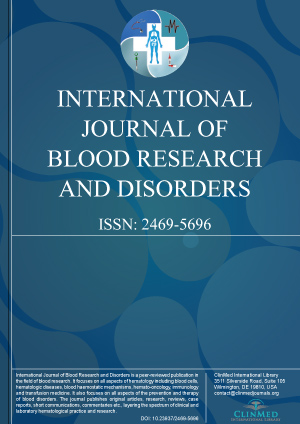Open Access DOI:10.23937/2469-5696/1410014
Pediatric B-cell Non-Hodgkin Lymphoma: 21-year Experience with FAB-LMB Protocols in a Single Institute in Greece
Apostolos Pourtsidis, Marina Servitzoglou, Margarita Baka, Despina Bouhoutsou, Maria Varvoutsi, Dimitrios Doganis, Katherine Strantzia-Michail and Helen Kosmidis
Article Type: Research Article | First Published: May 10, 2015
Aims and background: Our objective was to analyze the clinical and demographic characteristics of children with B-cell lymphoma treated in a single center over the last two decades. Methods: Data was collected by a retrospective review of the charts of all 76 patients treated to our unit, from 1990 to 2010, with FAB LMB 89, 96 protocols and 2003 modifications....
Open Access DOI:10.23937/2469-5696/1410013
Fetal and Neonatal Alloimmune Thrombocytopenia: Advances in Laboratory Diagnosis and Management
Hacene Brouk and Hanifa Ouelaa
Article Type: Review Article | First Published: April 30, 2015
Fetal and neonatal alloimmune thrombocytopenia (F/NAIT), caused by fetomaternal mismatch for human platelet (PLT) alloantigens (HPAs), is the commonest cause of severe thrombocytopenia in term neonates and is analogous to the fetal/neonatal anaemia caused by haemolytic disease of the newborn (HDN). The most feared complication of this syndrome is the occurrence of intracranial hemorrhage leading to death or neurological sequels....
Open Access DOI:10.23937/2469-5696/1410012
The Comparison between Microhematocrit and Automated Methods for Hematocrit Determination
Gebrewahd Gebretsadkan, Kebede Tessema, Henock Ambachew and Misganaw Birhaneselassie
Article Type: Research Article | First Published: April 01, 2015
Hematocrit is a test that measures a percentage of blood that is comprised of red blood cell. This is often referred to as packed cell volume (PCV) or erythrocyte volume fraction. It is considered as an integral part of a person's complete blood count, along with hemoglobin concentration, white blood cell count and platelet counts....
Open Access DOI:10.23937/2469-5696/1410011
Hemolytic Anemia in Alcohol-Induced Liver Disease: A Case Report on Zieve's Syndrome
Shefali Nath and Joshua R Peck
Article Type: Case Report | First Published: March 26, 2015
We report a case of Zieve's syndrome in a patient with a longstanding history of alcohol abuse admitted for acute alcoholic hepatitis. Zieve's syndrome is defied as the triad of hemolytic anemia, hypertriglyceridemia, and jaundice in patients with known liver disease. It is an uncommon diagnosis, but is an important one to consider in patients with known liver disease admitted with these constellation of signs and symptoms....
Open Access DOI:10.23937/2469-5696/1410010
Lenalidomide in patients with Relapsed or Refractory HTLV-1 Related Adult T cell Leukemia/Lymphoma (ATLL)
Adrienne A. Phillips, Jalanni Giddings, Shing M. Lee and Steven M. Horwitz
Article Type: Case Report | First Published: March 21, 2015
Adult T-cell Leukemia/Lymphoma (ATLL) is resistant to chemotherapy and the acute and lymphomatous subtypes of disease have a dismal prognosis. There is no standard therapy for relapsed or refractory disease in Western countries and new agents are being explored. Lenalidomide is an immunomodulatory agent with promising activity in hematologic malignancies, including non-Hodgkin's lymphoma and represents a novel therapeutic option. ...
Open Access DOI:10.23937/2469-5696/1410008
Thrombophilia: Demographics and Clinical Presentation in United Arab Emirates
Fatma H Sajwani and Moza A Khuzam
Article Type: Research Article | First Published: February 20, 2015
Thrombophilia is a group of disorders that increases the patient's risk of thrombosis. Inherited causes of thrombophilia are challenging to diagnose and once diagnosed may subject the patient to prolonged treatment. The extent of the condition is not well established in UAE and data on prevalence and demographics are lacking. This study aimed at setting a baseline data on the prevalence, demographics and clinical presentation of thrombophilia in UAE....
Open Access DOI:10.23937/2469-5696/1410007
HemoCue versus Complete Blood Count for Hemoglobin Measurement in Adults with Vaso-occlusive Crisis due to Sickle Cell Disease
Michael Bursey, Kane Curtis, Robert Gibson, Hongyan Xu and Matthew Lyon
Article Type: Research Article | First Published: February 17, 2015
Hemoglobin (Hgb) measurement is an important risk-stratification tool for patients presenting to the Emergency Department with vaso-occlusive crisis (VOC) from sickle cell disease (SCD). Point-of- care (POC) Hgb testing such as the HemoCue device decreases time to identification of significant anemia. However, there are no studies evaluating the accuracy of HemoCue testing in patients with SCD and VOC. The purpose of this study was to evaluate the correlation of Hgb measurements from HemoCue com...
Open Access DOI:10.23937/2469-5696/1410005
A Case of Localized Neuroblastoma in Caffey Disease, with Early and Uncommon Progression
Manuela Pagano, Chiara Galletto, Maurizio Bianchi and Franca Fagioli
Article Type: Case Report | First Published: January 21, 2015
Background: Caffey disease is a rare syndrome caused by mutation in the alpha-1 collagen type I gene, not described in literature as a predisposing condition to cancer development. Observation: We report a case of a 6-years-old female diagnosed with Caffey disease that developed a localized neuroblastoma. The patient had a poor clinical and radiological response with unusual disease dissemination and progression until death. Conclusion: The case is a rare example of rapid progression of localize...
Open Access DOI:10.23937/2469-5696/1410004
Diverse Genotype Presentation of the Saudi-Type Poly A Signal Mutation (αTsaudiα) in the Population of Bahrain
Nabeel Al Moamen, Fawzia Mahdi, Ahmed Thabet, Rugaya Abbas, Ebtihal Salman and Ahmed Al Alawi
Article Type: Letter to Editor | First Published: January 15, 2015
A total of 1187 patients with α-thalassemia phenotype presentation have been recruited for this investigation. Preliminary diagnosis of α-thalassemia was based on low hematological indices (MCV and MCH) of the red blood cells and/or persistently low hemoglobin levels, along with low or normal levels of HbA2 and absence of iron deficiency. Th molecular diagnosis of α-thalassemia was established by using a commercially available α-thalassemia strip assay (α-Globin StripAss...

